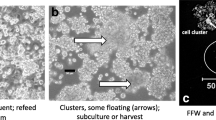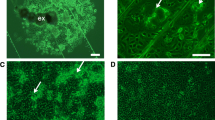Abstract
In vitro production of the obligate intracellular bacterium, Wolbachia pipientis, is essential to its manipulation as a genetic tool to spread transgenes within vector populations. We have adapted the Wolbachia-infected Aa23 Aedes albopictus mosquito cell line to Eagle’s minimal medium, supplemented with nonessential amino acids, glutamine, and 20% fetal bovine serum. When plated at low densities, Aa23E cells grew as patchy monolayers, comprised of non-contiguous clusters of cells that gave rise to solid clumps of tightly adherent cells. Multicellular clumps eventually detached from the substrate and floated freely in the medium. Removal of Wolbachia by treatment with tetracycline did not alter the cytological properties of the host cells, which had a population doubling time of 4–5 d. The presence of Wolbachia was monitored by Giemsa staining of cytological preparations, polymerase chain reaction (PCR) amplification of Wolbachia 16S ribosomal DNA, and by simultaneous PCR amplification of ribosomal protein genes from Wolbachia and mosquito host cell genomes. Wolbachia morphology was pleomorphic, and Wolbachia DNA persisted in the culture medium for several weeks after degradation of PCR-amplifiable host cell DNA.




Similar content being viewed by others
References
Dobson S. L.; Marsland E. J.; Veneti Z.; Bourtzis K.; O’Neill S. L. Characterization of Wolbachia host cell range via the in vitro establishment of infections. Appl. Environ. Microbiol. 68: 656–660; 2002.
Dulbecco R.; Vogt M. Plaque formation and isolation of pure lines with poliomyelitis virus. J. Exp. Med. 99: 167–182; 1954.
Dutton T. J.; Sinkins S. P. Strain-specific quantitation of Wolbachia density in Aedes albopictus and effects on larval rearing conditions. Insect Mol. Biol. 13: 317–322; 2004.
Fallon A. M. Transfection of cultured mosquito cells. In: CramptonJ. M.; BeardC. B.; LouisC. (eds) Molecular biology of insect disease vectors. Chapman and Hall, New York, pp 430–443; 1997.
Fallon A. M.; Kurtti T. J. Cultured cells as a tool for analysis of gene expression. In: MarquardtW. C. (ed) Biology of disease vectors. 2nd ed. Elsevier, New York, pp 539–549; 2005.
Fallon A. M.; Li L. The C-terminal extension that characterizes mosquito (Diptera: Culicidae) ribosomal protein S6 is widespread among the Culicomorpha. J. Med. Entomol. 44: 608–616; 2007.
Gerenday A.; Fallon A. M. Cell cycle parameters in Aedes albopictus mosquito cells. In Vitro Cell Dev. Biol., Anim. 32: 307–312; 1996.
Hernandez V. P.; Higgins L. A.; Schwientek M. S.; Fallon A. M. The histone-like C-terminal extension in ribosomal protein S6 in Aedes and Anopheles mosquitoes is encoded within the distal portion of exon 3. Insect Biochem. Mol. Biol. 33: 901–910; 2003.
Hertig M. The Rickettsia, Wolbachia pipientis (gen et sp. n.) and associated inclusions of the mosquito, Culex pipiens. Parasitology 28: 453–486; 1936.
Lo N.; Casiraghi M.; Salati E.; Bazzocchi C.; Bandi C. How many Wolbachia supergroups exist? Mol. Biol. Evol. 19: 341–346; 2002.
O’Neill S. L.; Giordano R.; Colbert A. M. E.; Karr T. L.; Robertson H. M. 16S rRNA phylogenetic analysis of the bacterial endosymbionts associated with cytoplasmic incompatibility in insects. Proc. Natl. Acad Sci. U. S. A. 89: 2699–2702; 1992.
O’Neill S. L.; Pettigrew M. M.; Sinkins S. P.; Braig H. R.; Andreadis T. G.; Tesh R. B. In vitro cultivation of Wolbachia pipientis in an Aedes albopictus cell line. Insect Mol. Biol. 6: 33–39; 1997.
Rasgon J. L.; Gamston C. E.; Ren X. Survival of Wolbachia pipientis in cell-free medium. Appl. Env. Microbiol. 72: 6934–6937; 2006.
Ruang-areerate T.; Kittayapong P.; McGraw E. A.; Baimai V.; O’Neill S. L. Wolbachia replication and host cell division in Aedes albopictus. Curr. Microbiol. 49: 10–12; 2004.
Saito K.; Mattheakis L. C.; Nomura M. Post-transcriptional regulation of the str operon in Escherichia coli. Ribosomal protein S7 inhibits coupled translation of S7 but not its independent translation. J. Mol. Biol. 235: 111–124; 1994.
Sasaki T.; Braig H. R.; O’Neill S. L. Analysis of Wolbachia protein synthesis in Drosophila in vivo. Insect Mol. Biol. 7: 101–105; 1998.
Schneider I. Differentiation of larval Drosophila eye-antennal discs in vitro. J. Exp. Zool. 156: 91–104; 1964.
Shih K. M.; Gerenday A.; Fallon A. M. Culture of mosquito cells in Eagle’s medium. In Vitro Cell Dev. Biol., Anim. 34: 629–630; 1998.
Sinkins S. P. Wolbachia and cytoplasmic incompatibility in mosquitoes. Insect Biochem. Mol. Biol. 34: 723–729; 2004.
Sinkins S. P.; Gould F. Gene drive systems for insect disease vectors. Nat. Rev., Genet. 7: 427–435; 2006.
Varma M. G. R.; Pudney M. The growth and serial passage of cell lines from Aedes aegypti (L.) larvae in different media. J. Med. Entomol. 6: 432–439; 1969.
Wu M.; Sun L. V.; Vamathevan J.; Riegler M.; Deboy R.; Brownlie J. C. et al. Phylogenomics of the reproductive parasite Wolbachia pipientis wMel: A streamlined genome overrun by mobile genetic elements. PloS Biol. 2: E69; 2004.
Yen J. H.; Barr A. R. New hypothesis of the cause of cytoplasmic incompatibility in Culex pipiens L. Nature 232: 657–658; 1971.
Acknowledgments
This work was supported by NIH grant AI070913 and by the University of Minnesota Agricultural Experiment Station, St. Paul, MN. I thank Anna Gerenday for technical assistance and Drs. TJ Kurtti, UG Munderloh and A Gerenday for helpful discussions.
Author information
Authors and Affiliations
Corresponding author
Additional information
Editor: J. Denry Sato
Rights and permissions
About this article
Cite this article
Fallon, A.M. Cytological properties of an Aedes albopictus mosquito cell line infected with Wolbachia strain wAlbB. In Vitro Cell.Dev.Biol.-Animal 44, 154–161 (2008). https://doi.org/10.1007/s11626-008-9090-4
Received:
Accepted:
Published:
Issue Date:
DOI: https://doi.org/10.1007/s11626-008-9090-4




